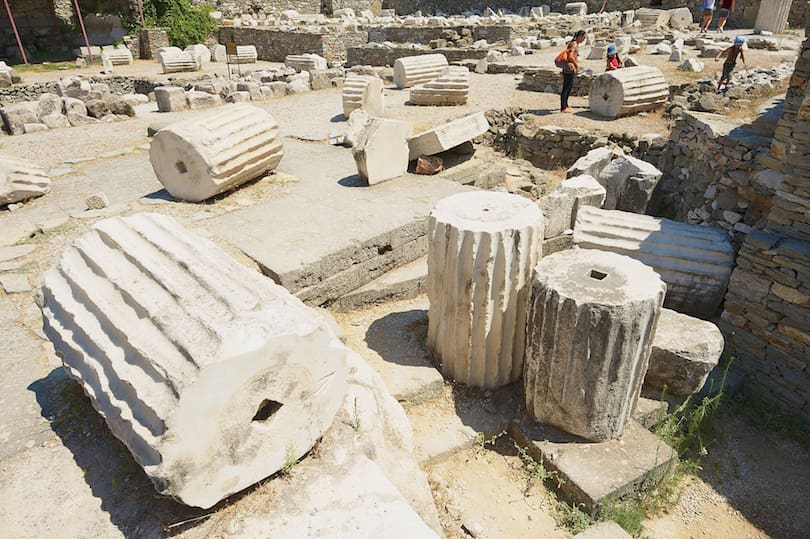Ayodhya, a city rich in history and spirituality, is a revered destination for millions of devotees and history enthusiasts. Situated on the banks of the holy river Sarayu in the Indian state of Uttar Pradesh, Ayodhya holds immense significance in Hindu mythology, particularly as the birthplace of Lord Rama. This ancient city offers a plethora of sacred sites, temples, and cultural landmarks that showcase its religious and historical heritage. In this article, we will explore the top eight places to visit in Ayodhya, each encompassing its unique charm and cultural significance.
Ayodhya: A Historical and Spiritual Destination
The significance of Ayodhya in Hinduism
Ayodhya is considered one of the seven most sacred cities in Hinduism and holds deep religious importance. According to ancient texts, Ayodhya was the capital of the mighty Kosala Kingdom, ruled by the renowned King Dasharatha, father of Lord Rama. It is believed to be the birthplace of Lord Rama, making it a place of immense devotion and reverence for Hindus worldwide.
Ayodhya’s connection to Lord Rama
Lord Rama, the seventh avatar of Lord Vishnu, is a central figure in Hindu mythology. Ayodhya is intrinsically linked to the epic Ramayana, which narrates the life and adventures of Lord Rama. The city is believed to be the stage where the grandeur of his birth, childhood, and eventual return as the rightful king unfolded. The religious and cultural fabric of Ayodhya is intricately woven around the legends and teachings associated with Lord Rama.
Ram Janmabhoomi: The Birthplace of Lord Rama
Historical background of Ram Janmabhoomi
Ram Janmabhoomi, also known as the Ram Janmasthan, is the revered site believed to be the birthplace of Lord Rama. It gained significant attention due to the Ram Janmabhoomi-Babri Masjid dispute, which was finally resolved with the construction of a grand temple dedicated to Lord Rama. The history and religious sentiments associated with Ram Janmabhoomi make it a must-visit place for devotees and history enthusiasts.
The Ram Janmabhoomi temple complex
The magnificent Ram Janmabhoomi temple complex stands as a testament to the enduring faith and devotion of millions of devotees. The complex comprises various structures, including the main temple, dedicated to Lord Rama, and other shrines dedicated to deities associated with him, such as Lord Hanuman and Goddess Sita. The architecture and intricate carvings within the temple complex depict scenes from the Ramayana and showcase the rich cultural heritage of Ayodhya.
Experiencing the spirituality of Ram Janmabhoomi
Visiting Ram Janmabhoomi allows devotees to experience a deep sense of spirituality and connect with the divine. The serene ambiance, the resonating chants, and the fragrance of incense create an atmosphere conducive to introspection and devotion. Devotees offer prayers, seek blessings, and immerse themselves in the captivating aura of the temple complex, reaffirming their faith and devotion to Lord Rama.
Hanuman Garhi: A Devotee’s Haven
History and importance of Hanuman Garhi
Hanuman Garhi, an ancient temple dedicated to Lord Hanuman, is located in the heart of Ayodhya. This fortress-like temple is said to have been built at the spot where Lord Hanuman guarded the gates of Ayodhya while Lord Rama was in exile. The temple holds immense religious significance and is considered a symbol of Lord Hanuman’s unwavering devotion and loyalty.
Visiting Hanuman Garhi
As one approaches Hanuman Garhi, the sight of the grand temple complex atop a hill evokes a sense of awe and reverence. The climb up the steep staircase rewards devotees with panoramic views of Ayodhya and the Sarayu River. Inside the temple, the idol of Lord Hanuman, adorned with vibrant garlands, attracts devotees who seek his blessings for strength, courage, and protection. The tranquil ambiance of Hanuman Garhi offers solace and a sense of peace to all who visit.
Kanak Bhawan: A Glorious Abode
The legend behind Kanak Bhawan
Kanak Bhawan is a splendid palace-like structure dedicated to Lord Rama and Goddess Sita. According to folklore, it is believed to be the house gifted by King Dasharatha to his beloved daughter-in-law, Sita, after her marriage to Lord Rama. The name “Kanak Bhawan” translates to “House of Gold,” symbolizing the opulence and grandeur associated with the divine couple.
Highlights of Kanak Bhawan
Step into Kanak Bhawan, and you will be captivated by its intricate architecture and the vibrant colors that adorn its walls. The temple houses beautifully adorned idols of Lord Rama and Goddess Sita, attracting devotees who come to seek their blessings and offer their prayers. The sanctum sanctorum radiates a sense of divinity, and the temple complex offers a serene environment for devotees to engage in spiritual contemplation.
Nageshwarnath Temple: A Symbol of Devotion
Ancient history of Nageshwarnath Temple
Nageshwarnath Temple, situated on the banks of the Sarayu River, is one of the oldest temples in Ayodhya. It is believed to have been established by Lord Rama’s son, King Kusha, and holds immense historical and religious significance. The temple is dedicated to Lord Shiva, the destroyer of evil, and attracts devotees from far and wide.
Spiritual significance and rituals at Nageshwarnath Temple
Devotees flock to Nageshwarnath Temple to seek the blessings of Lord Shiva and offer prayers for peace, prosperity, and liberation from worldly attachments. The temple’s serene ambiance, amidst the natural beauty of Ayodhya, creates an atmosphere of spiritual awakening and devotion. The rhythmic chants, the fragrance of incense, and the sight of devotees engrossed in prayer create a divine aura that leaves a lasting impression on visitors.
Guptar Ghat: A Riverside Retreat
The serene beauty of Guptar Ghat
Guptar Ghat is a picturesque and tranquil spot located on the banks of the Sarayu River. The ghat offers a serene retreat where visitors can immerse themselves in the natural beauty and find solace in the gentle flow of the sacred river. Surrounded by lush greenery and ancient trees, Guptar Ghat provides a serene atmosphere for meditation and introspection.
Religious rituals and beliefs associated with Guptar Ghat
Guptar Ghat holds immense religious significance as it is believed to be the spot where Lord Rama took his Jal Samadhi, a ceremonial water immersion performed before his departure from the mortal world. Devotees visit Guptar Ghat to perform religious rituals, offer prayers, and take a holy dip in the Sarayu River, seeking spiritual purification and liberation.
Tulsi Smarak Bhawan: A Tribute to Goswami Tulsidas
Life and works of Goswami Tulsidas
Goswami Tulsidas, a renowned saint and poet, played a pivotal role in spreading the glory and teachings of Lord Rama through his epic work, the Ramcharitmanas. Tulsi Smarak Bhawan is a tribute to his contributions and serves as a place for devotees to pay homage to this revered saint.
Exploring Tulsi Smarak Bhawan
Tulsi Smarak Bhawan showcases the life and works of Goswami Tulsidas through paintings, sculptures, and artifacts. Visitors can learn about the poet’s journey, his devotion to Lord Rama, and the impact of his writings on Indian literature and spirituality. The serene ambiance of the Bhawan encourages contemplation and reflection, allowing visitors to connect with the poet-saint’s teachings and seek inspiration for their spiritual journey.
Ayodhya: A Cultural Marvel
Celebrating Ayodhya’s rich culture
Ayodhya is not just a city of temples and historical sites; it is also a treasure trove of rich cultural heritage. The city’s vibrant culture finds expression in its art, music, dance, and festivals, which are deeply intertwined with its religious fabric. From classical music and dance performances to colorful festivals like Ram Navami and Diwali, Ayodhya offers a glimpse into the cultural tapestry of India.
Folk music and dance performances
Visitors to Ayodhya can witness captivating folk music and dance performances that bring the city’s cultural heritage to life. Traditional forms like Kathak, a classical dance form, and bhajan-kirtan, devotional singing, resonate through the streets of Ayodhya. These performances not only entertain but also evoke a sense of joy, devotion, and cultural pride in both locals and tourists.
Sita Ki Rasoi: A Culinary Journey
The legend of Sita Ki Rasoi
Sita Ki Rasoi, which translates to “Sita’s Kitchen,” is a place steeped in mythology and culinary heritage. According to legend, it is believed to be the spot where Goddess Sita cooked meals for Lord Rama during their exile in the forest. This sacred kitchen showcases the significance of food and its role in nourishing the body and soul.
Authentic flavors and delicious offerings
Sita Ki Rasoi offers a unique culinary experience where visitors can savor authentic Ayodhya cuisine. Traditional dishes prepared with love and devotion, using age-old recipes and local ingredients, are served to guests. From aromatic rice dishes to mouthwatering sweets, the flavors of Ayodhya come alive in every bite, taking visitors on a delightful gastronomic journey.
Conclusion
Ayodhya, with its deep-rooted history, spirituality, and cultural marvels, offers an enriching experience for every visitor. From the sacred temples and historical sites to the captivating cultural performances and culinary delights, Ayodhya’s charm is undeniable. Exploring the top eight places mentioned in this article will provide a glimpse into Ayodhya’s soul, leaving visitors with lasting memories and a profound sense of spiritual awakening.
FAQs
- What is the best time to visit Ayodhya? The best time to visit Ayodhya is during the months of October to March when the weather is pleasant and conducive for exploration.
- Are there any accommodation options in Ayodhya? Yes, Ayodhya offers a range of accommodation options, including hotels, guesthouses, and ashrams, catering to various budgets and preferences.
- How can I reach Ayodhya? Ayodhya is well-connected by road, rail, and air. The nearest airport is in Lucknow, and regular train and bus services are available from major cities in India.
- Is photography allowed in the temples of Ayodhya? Photography may be allowed in some temples, but it is advisable to seek permission before capturing any photographs. Respect the religious sentiments and guidelines of each temple.
- Are there any local markets in Ayodhya? Yes, Ayodhya has vibrant local markets where you can explore and purchase traditional handicrafts, textiles, and religious artifacts as souvenirs of your visit.
















After all, what a great site and informative posts, I will upload inbound link – bookmark this web site? Regards, Reader.
certainly like your web-site however you need to check the spelling on several of your posts. Many of them are rife with spelling issues and I find it very bothersome to tell the truth however I¦ll surely come back again.
Thank you for the sensible critique. Me & my neighbor were just preparing to do some research on this. We got a grab a book from our local library but I think I learned more clear from this post. I’m very glad to see such wonderful info being shared freely out there.
Hello there, You’ve done an incredible job. I will certainly digg it and for my part suggest to my friends. I am sure they will be benefited from this website.
I am glad for writing to make you understand of the beneficial experience my wife’s princess gained reading your web page. She realized some issues, most notably how it is like to have a wonderful helping character to get folks with no trouble know a number of complicated subject areas. You actually did more than our desires. Thank you for delivering those valuable, trustworthy, edifying not to mention fun tips about that topic to Lizeth.